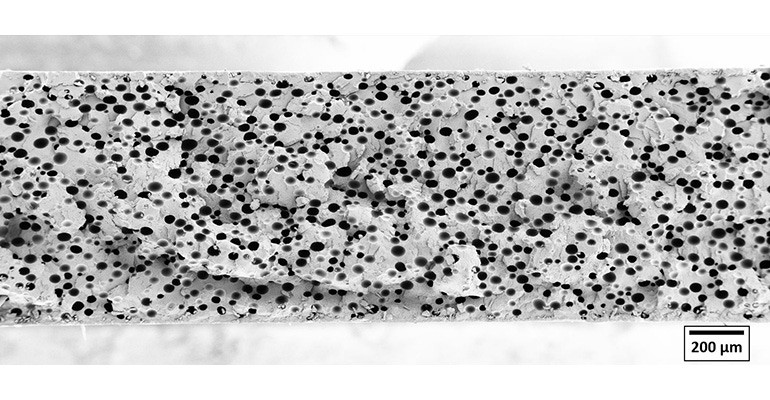A proprietary process that creates small, evenly distributed cells lightweights parts while maintaining mechanical properties.
November 15, 2022

New foam extrusion technology from Switzerland’s Promix Solutions promises to reduce raw material consumption by 20% thanks to a proprietary process that creates small, evenly distributed cells.
Foam with 50-micron-sized cells has 27 times more cells than foam with cells measuring 150-microns at the same density, Promix said. The company’s Microcell Technology relies on multiple factors to create those tiny cells, including high-precision dispensing of blowing fluids in the supercritical stage, unique cooling and mixing equipment, and special nucleation technology. The company uses environmentally friendly CO2 and nitrogen blowing agents.
As an example, a thermoformed PET tray foamed with Microcell Technology was 18% lighter than a solid tray but exhibited the same mechanical top-load properties. A non-foamed benchmark tray was also 18% lighter, but with significantly reduced top-load properties.
Promix supplies the turnkey hardware as well as know-how and support to help its customers achieve these results, said CEO Rolf Heusser.
While the company’s foaming technology has been available for many years, “the recent further improvement in cell-size reduction offers the full potential of raw material savings,” said Heusser. “If cells are too big, the mechanical properties will (suffer).”
To maintain the mechanical properties with conventional foaming technology, “you had to compensate with a thicker sheet — for example, 30% foaming but only 10% weight reduction because of increased thickness in comparison to non-foamed sheets,” he explained. “With Microcell Technology, you can maintain the thickness and fully benefit from the reduction.”
The technology “works for all extrusion processes with CO2 and nitrogen — sheets for thermoforming, boards, pipes, profiles, cables, blown film, and extrusion blow molding,” he added.
About the Author(s)
You May Also Like


